A blog dedicated to Ancient Near East religious and cultural studies with a focus on Mesopotamia. (Ancient Iraq)
Don't wanna be here? Send us removal request.
Photo
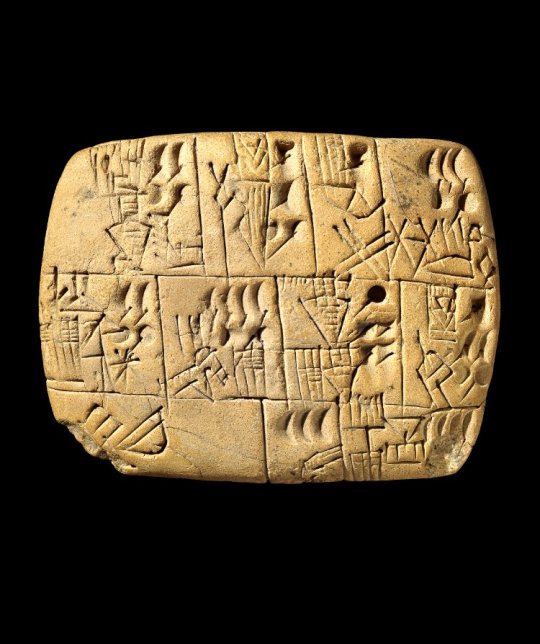
Cuneiform tablet counting beer for the workers. Circa 3100-3000 B.C, from Uruk in what is now southern Iraq. Now in the British Museum.
The beer on the tablet is represented by a jar with a pointed base. Food is symbolized by a head eating from a bowl (bottom left). The semicircular imprints (possibly made by the edge of a finger) stand for the measurements.
~Hasmonean
#artifacts#mesopotamia#mesopotamian#archaeology#ane#ane studies#ancient near east#iraq#sumer#sumeria#sumerian#babylon#cuneiform#babylonian#uruk
460 notes
·
View notes
Photo
AMAZING!

Lilith and Asherah goddess at Durga Puja pandal, Bengal, photo by Aradhya Gauranga
455 notes
·
View notes
Photo

Almost halfway done with the Phoenician alphabet oracle. There are 22 letters/cards in total and I’ve worked 16 deities into it (the Phoenician, Canaanite and Mesopotamian gods are so heavily syncretized through both geography and time that it was a challenge to choose among all the figures and portrayals, but the full list is below the cut:
Keep reading
#phoenician oracle#phoenician alphabet#oracle#deck#tarot#divination#art#polytheism#ancient world#ancient near east#mesopotamia#canaan#ane
734 notes
·
View notes
Link
Learn some Akkadian!
The following link has some resources for early leaners who want to know what the ancient Akkadian language is. The creator is currently working on a bigger resource for helpful learning, but in the mean time this is a good place to start if you want to learn an ancient language.
~Hasmonean
#learning#languages#language#ancient languages#akkadian#akkadia#mesopotamia#mesopotamian#ane#ane studies#ancient near east#cuneiform#writing#ancient writing
316 notes
·
View notes
Photo
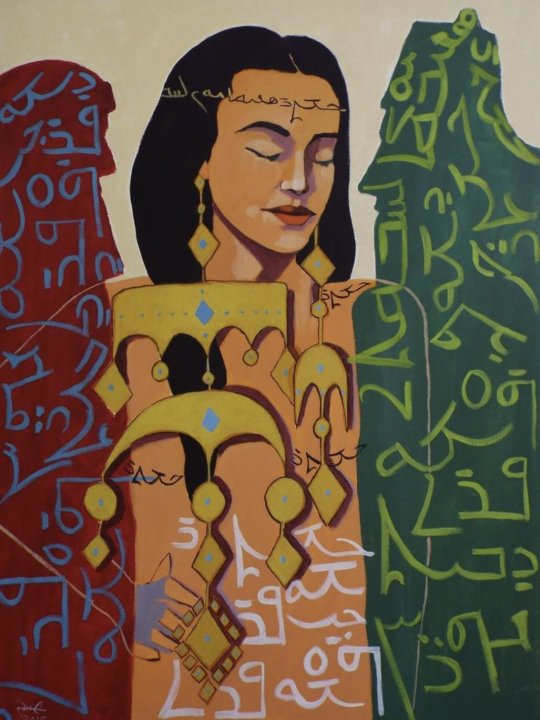
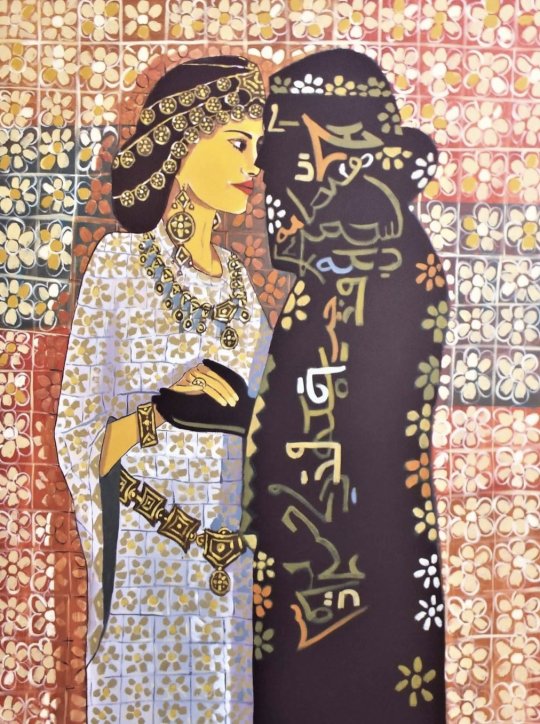
Ishtar Gate and Ishtar Lover by Iraqi artist Paul Batou
~Hasmonean
#art#paul batou#iraq#iraqi#iraqi artists#middle east#middle eastern art#ishtar#inanna#goddess#goddesses#ishtar gates#flowers#ane#ane studies#ancient near east#mesopotamia#mesopotamian#assyrian
375 notes
·
View notes
Note
I took a DNA test and my earliest ancestry is from the Middle East and Iberian peninsula. (2% West Asian here.) This was a coincidence as I was already into Mesopotamia and the ANE.
1% is Levant, Israel, Syria etc area and the other 1% is from Iraq, Iran, and that area showing migration patterns. The other 1% is from Iberian peninsula from the other side of North Africa, near Spain.
My ancestors skipped Southern Europe all together and the rest of my DNA is from Western Europe and Northern Europe.
I was perplexed by this. Why does my DNA hit on the other side of North Africa? Why didn't my ancestors mingle with anyone in Southern Europe? Later I found out a Carthaginian colony was in that area in the Iberian.
My not so academic hypothesis to this is that my ancestors must have been Carthaginian which directly relates them to the Phoenicians. Since Carthaginians aren't fond of Greece and especially Rome, being historically at each other's throats... Instead of mingling, they left for Northern Europe to get away from Rome which is why the next lowest percentage is 4% Irish. (Romans never made it there.) But there is no way to prove it.
Honestly happy to have a genetic connection to Mesopotamia myself.
- L.
Just stumbled upon your blog and just wanted to say thank you for taking the time to put out such beautiful, rich history! Do you have any ancestry from Mesopotamia? I have Lebanese/Syrian blood and I've recently discovered I had Persian ancestry (thus why I'm so interested in this topic) Salam Alaikum :)
Your welcome!
I can’t speak for the other admin, but all I can say is that my paternal grandmother’s mother was Sicilian and that Sicily was occupied for nearly 300 years back in the medieval period by an Arab emirate. It is possible that some Arab mixed in then, but I can’t say for certain as I don’t have a lot of records for my paternal grandmother’s mother’s family and I don’t want to pull an Elizabeth Warren. When my father did a DNA test he said he had a small percentage of Middle Eastern DNA but it wasn’t specific to what region.
~Hasmonean
16 notes
·
View notes
Link
Whenever we hear or see Muslims discussing sex and sexuality we often see or hear them being very strict and prudish. However, this has not always been the case. Whether it was discussing what was permissible, what was frowned upon but necessarily banned, and what was banned many (mostly male) Muslims throughout history had detailed discussions on certain sex acts and sexual representations. They drew on the science of the time, philosophy, and religious texts such as the Qu’ran and hadiths to give detailed discussions.
This wonderful essay gives light to how Muslims in history went from detailed discussions to more stricter ideas influenced by colonialism.
~Hasmonean
52 notes
·
View notes
Note
Just stumbled upon your blog and just wanted to say thank you for taking the time to put out such beautiful, rich history! Do you have any ancestry from Mesopotamia? I have Lebanese/Syrian blood and I've recently discovered I had Persian ancestry (thus why I'm so interested in this topic) Salam Alaikum :)
Your welcome!
I can’t speak for the other admin, but all I can say is that my paternal grandmother’s mother was Sicilian and that Sicily was occupied for nearly 300 years back in the medieval period by an Arab emirate. It is possible that some Arab mixed in then, but I can’t say for certain as I don’t have a lot of records for my paternal grandmother’s mother’s family and I don’t want to pull an Elizabeth Warren. When my father did a DNA test he said he had a small percentage of Middle Eastern DNA but it wasn’t specific to what region.
~Hasmonean
16 notes
·
View notes
Text
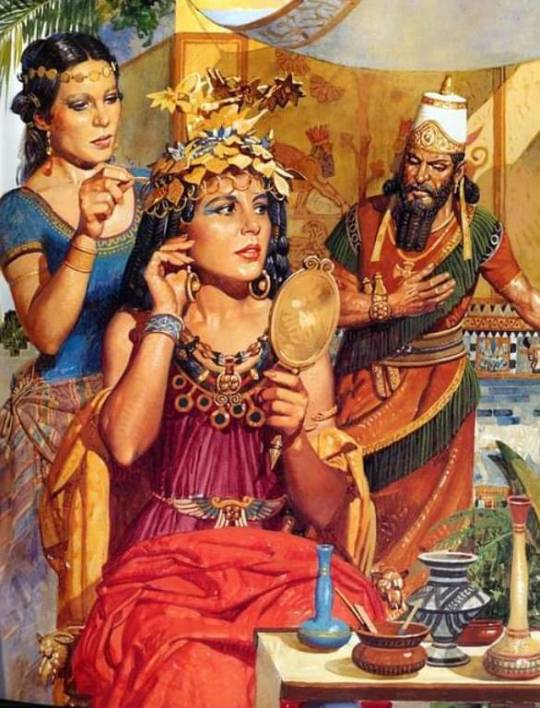
Queen of Assyria, Semiramus, by Roger Payne
275 notes
·
View notes
Photo
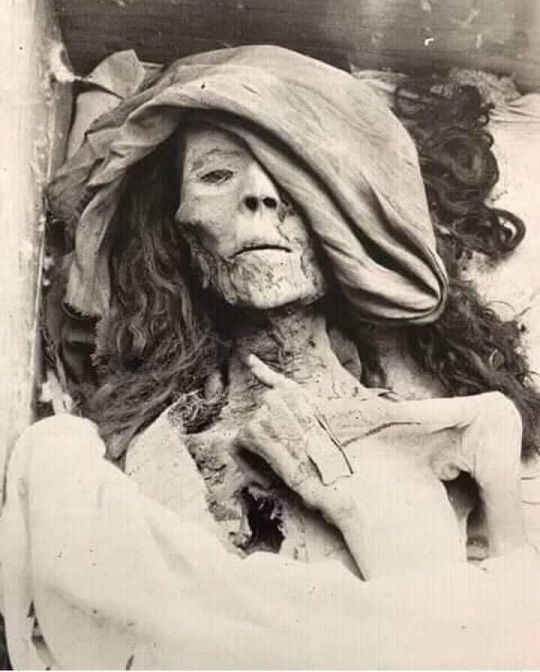
Mummy of Queen Tiye, the mother of Akhenaten and grandmother of Tutankhamun now in the Egyptian Museum.
~Hasmonean
#mummy#mummies#tiye#akhenaten#tutankhamun#king tut#death#egyptian#egypt#ancient egyptians#ancient egypt
397 notes
·
View notes
Photo

Fravashi (fravaši, /frəˈvɑːʃi/) is the Avestan language term for the Zoroastrian concept of a personal spirit of an individual, whether dead, living, and yet-unborn.
#fravashi#religion#zoroastrianism#avestan#middle east#ane#ane studies#ancient near east#persia#spirits
278 notes
·
View notes
Photo




The ruined city of Arg-e-Bam is made entirely of mud bricks, clay, straw and the trunks of palm trees. The Iranian city was originally founded during the Sassanian period (224-637 CE) and while some of the surviving structures date from before the 1100s, most of what remains was built during the Safavid period (1502-1722).
Bam prospered because of pilgrims visiting its Zoroastrian fire temple, which had been built early in the Sassanian period, and because Bam was a trading hub along the Silk Road. It was later the site of Jame Mosque, built during the Saffarian period (866-903 CE). Next to the mosque is the tomb of Mirza Naiim, a mystic and astronomer.
The city was largely abandoned since a series of invasions in the early 1800s. In 1953, work began to intensively restore Arg-e-Bam. Restoration work continued until December 26, 2003, when a massive earthquake hit the area – an estimated 6.6 on the Richter Scale. Almost everything in Bam was destroyed. After that, restoration was given up, and today Arg-e-Bam is at the mercy of the elements.
6K notes
·
View notes
Photo
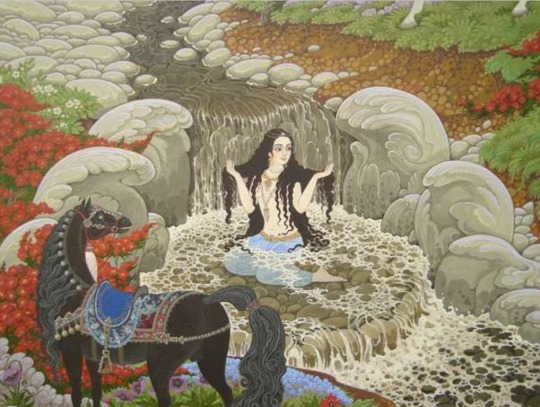
Detail of Shirin, Queen of the Sassanian Empire, bathing. The hooves of the horse of King Khosrow can be seen at the top right. From the Kashmir Manuscript, 1791.
Shirin was the wife of Khosrow II, the shahanshah, or King of Kings, of the Sassanian (Persian) Empire. Her exact cultural/ethnic origins are debated; some sources say she was Roman (at her time that was the Byzantine Empire who considered themselves Roman) and others say she was Aramean, a non-Persian from the areas of Assyria and Babylonia.
What is known is that she was a Christian and Khosrow was Zoroastrian and that such a relationship was considered forbidden. Through all the turmoil in their lives, Shirin and Khosrow remained together. During that time she was able to gain support for the Christian minority in the empire.
Her and Khosrow’s lives and romance are retold, with fictional elements, in the Persian epic poem Shahnameh, the romance Khosrow and Shirin by the famed poet Nizami Ganjavi, and even in One Thousand and One Nights.
~Hasmonean
#art#women#women in art#women in history#shirin#khosrow#middle east#middle eastern history#persia#persian empire#sassanian empire#romance#shahnameh#nizami ganjavi#one thousand and one nights#1001 nights#assyria#babylon#christianity#syria#iran#iraq
558 notes
·
View notes
Text
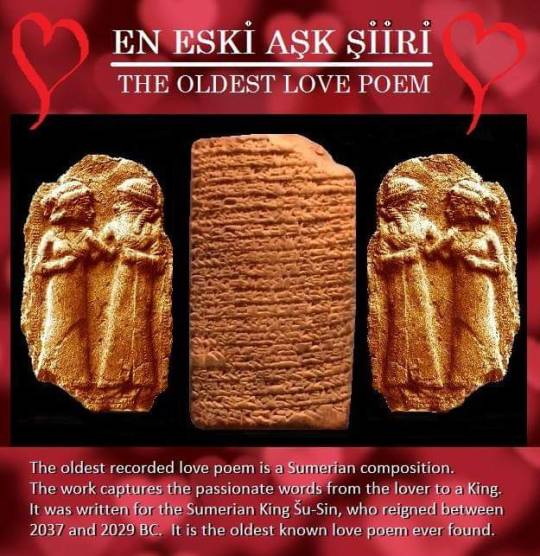
Happy Valentine's day from our friends at Temple of Sumer.
-L.
69 notes
·
View notes
Photo

~ Bull’s head ornament for a lyre. Period: Early Dynastic III Date: ca. 2600–2350 B.C. Place of origin: Mesopotamia Culture: Sumerian Medium: Bronze, inlaid with shell and lapis lazuli.
725 notes
·
View notes
Photo

Neo-Assyrian stamp seals depicting a dog (top) and the goddess Gula on her throne resting on a dog with an attendant. Circa 700-600 B.C. Now in the British Museum. Gula was the Assyrian goddess of healing and the dog was her attribute. It was believed that if you neglected or harmed your dog then that would incur the goddess’ wrath.
~Hasmonean
2K notes
·
View notes
Photo
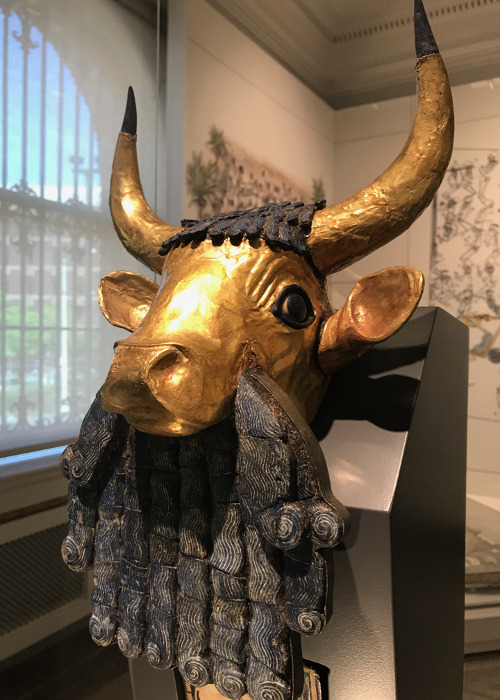
The Bull-Headed Lyre of Ur, the world’s oldest surviving stringed instrument, dating back to ancient Mesopotamia’s Early Dynastic III Period (2550–2450 BCE). University of Pennsylvania Museum of Archaeology and Anthropology, Philadelphia, PA.
Photo by Babylon Chronicle
2K notes
·
View notes